BRIAN WATSON DURING WORLD WAR TWO
I have quite a bit of information on Brian Watson simply because he was my father and only a small amount on his brothers.
But for more on them (and others) see WAR AND OUR FAMILY.
For Brian's wartime sketch book see CAIRO SKETCH BOOK
You will see elsewhere that my father was an aspiring architect before the war. I do not know quite when and how this fits in since being posted to the Kaffarian Rifles, but with there being a period between that in 1940 and being sent to North Africa in 1942 he was used in other ways. Nahoon Reef at East London is an internationally recognised surfing spot and I used to paddle ski and wind surf there. The dirt road to it was evidently built by the army and my father participated. His fledgling architectural skills were put to designing a concrete radar station. Its free form shapes being difficult to discern from the sea. A similar one survives near Port Elizabeth although both of these and others have since been altered to suit modern installations or left to decay.
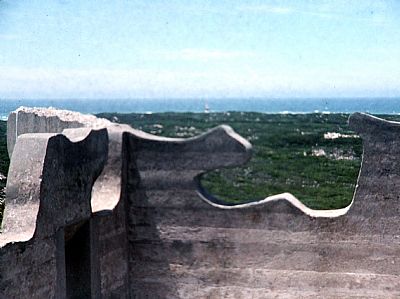
This is a similar structure just down the coast from Port Elizabeth at Schoenmakerskop based on the same design. It was known as the Fortress Observation Post. Baracks and other buildings were more concealed within the terrain below it. It was used by Athol Fugard in one of his short films. I took this photo in the mid-1970s.
Amongst the papers in my possession is the following typed posting letter:
BATTALION HEADQUARTERS
The Kaffarian Rifes,
East London
Date ....26/3/40....
No...N/N...
Rank & Name...Pte...B. W. Watson...
...4 Seaview Terrace,
... EAST LONDON...
POSTING.
You have been posted to "A" Company, The Kaffrarian Rifles, and you will report to the Officer Commanding "A" Company at the Drill Hall, at 1945 hrs on .....1/4/40.....
Signature
Capt & Adjutant
The Kaffrarian Rifles.
Much of this overlaps with WAR AND OUR FAMILY, but I have much more material for Brian, my father and so have given him his own section.
BRIAN WATSON AND THE KAFFRARIAN RIFLES AT SEA
His regiment, the Kaffrarian Rifles, travelled by ship from Durban to Egypt during WWII, heading from there overland for what is now Libya in north Africa. While we can find records at each end, I can't find anything of the voyages as ship movement could not be discussed during the war. Fortunately he kept as much as possible from the time including these newspaper cuttings of the troops boarding the ships. You may notice he has written "myself" in pencil next to "John Ritchie" at the bottom left photo of the first cutting.
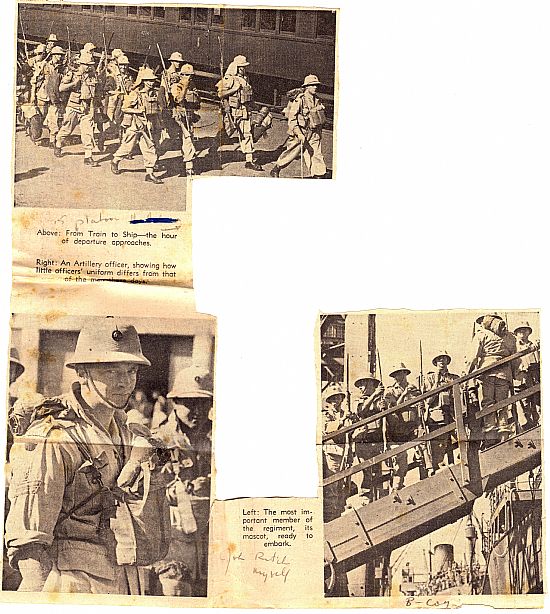
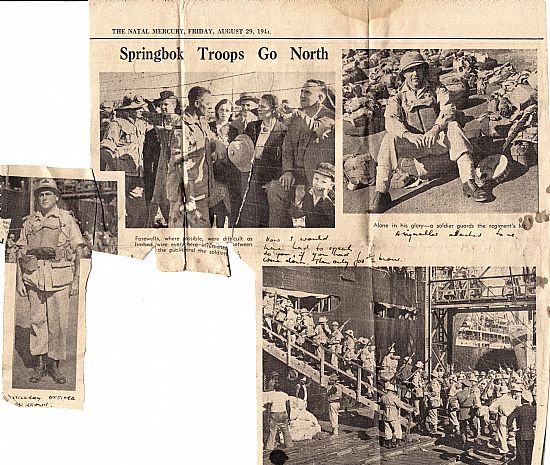
He also sketched and produced watercolour pictures and these include some of the naval shipping that he saw.
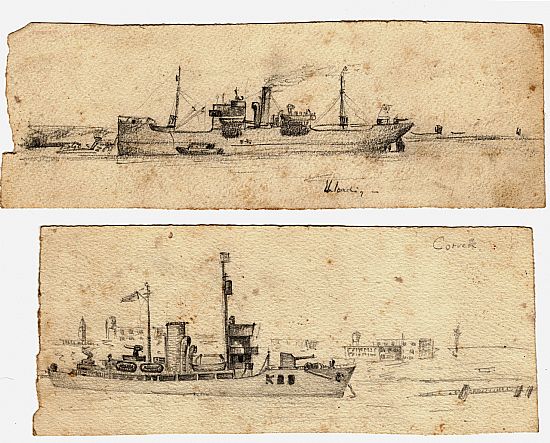
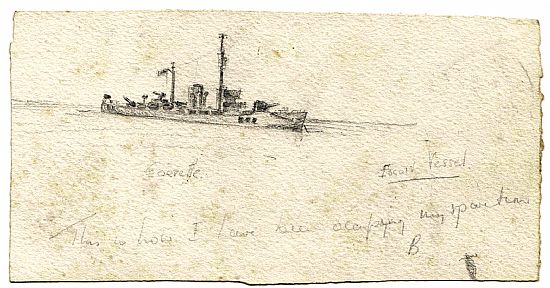
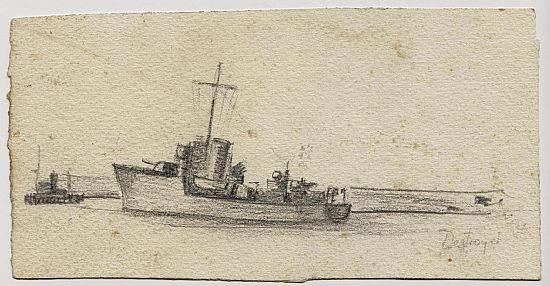
I also have a small sketch book with sketches and watercolours which he bought in Cairo before being sent on into the desert. CAIRO SKETCH BOOK
His mother Maud received a letter from The South African Red Cross dated 14th July, 1942. It was in a standard format with details filled in and read :
Mrs. E. M. Watson,
4, Seaview Terrace.
EAST LONDON.
Dear Mrs. Watson,
This is to inform you that we have instituted cabled enquiries re the welfare of Rifleman Brian Watson Watson and to say how much we hope that we shall soon have good news for you.
We want to tell you why quite a long period must lapse before conclusive news can be obtained so that you will understand why you must not give up hope if you do not hear from us for some time.
Before we can receive news that your son is a prisoner-of-war, this communication must be sent by the capturing power from the scene of operation to the Official Prisoner-of-War Bureau. From there it is cabled to the International Red Cross in Geneva and from Geneva to us.
The International Red Cross at Geneva, which is also the Central Agency for Prisoners-of-War everywhere, is now dealing with the many millions of enquiries for missing men. We mention this in order that you should realise that a delay from this end is also likely to be expected.
We regret to advise you that you cannot write until your son is confirmed prisoner-of-war, and parcels may not be sent until a full camp address is known. We will send you all regulations in this respect as soon as you are able to make use of them.
We hope sincerely that these few facts will have served to ease your mind, and assure you of our very real sympathy in these anxious times.
Yours sincerely,
signature
For : GENERAL SECRETARY.
Then Maud received the following.
REGISTERED WRC/7/ 79/22242/M/P
Officer-in-Charge
War Records.
Defence Headquarters,
Pretoria.
20-7-1942
Dear Mrs. Watson,
It is with great regret that I have to confirm my telegram informing you that your son Rfn. Brian Watson Watson,
was reported “missing, believed prisoner of war,” on the 20 June 1942.
It will be helpful for you to know that in all cases where men are reported missing, I inform the South African Red Cross Society, which immediately transmits cabled enquiries through the International Red Cross Committee at Geneva. If therefore, it is confirmed that he is a prinsoner of war, you will receive information either from me, or from the Red Cross Society immediately conclusive news is obtained.
In that regard it will be unnecessary to add that because of the almost universal extent of the war, and the large number of enquiries reaching Geneva, some exercise of patience, whilst admittedly difficult, is necessary. But you may be assured that everything possible is being and will be done to relieve your anxiety as soon as it is humanly possible to do so.
It will be of interest, and probably you are already aware, that broadcasts from Rome and the Vatican City frequently contain information relating to prisoner-of-war. My office has accordingly arranged for copies of these broadcasts to be supplied to it, and any relevant information which may result will be passed to you at once.
In the meantime, if you have enquiries to make in relation to pay matters, please communicate direct with the Paymaster at Pretoria, who will deal with them promptly. His address is :-
CHIEF PAYMASTER. U. D. F.,
“V” Buildings,
Beatrix Street,
PRETORIA.
I would conclude by saying, however, that the Department of Defence would feel privileged to be at your service in any other way within its power, if you will be good enough to address yourself to me.
Yours truly,
signature
Officer-in-Charge
War Records.
I have a copy of that telegram.
Then a second letter arrived from the Red Cross dated 28th July, 1942.
Dear Mrs. Watson,
We are in receipt of your letter of the 22nd instant, for which we thank you. We are delighted to hear that your son, Rifleman W. Watson, has rejoined his Unit, and offer our sincere good wishes for his continued well-being.
With regard to your son, Rifleman Edward Graham Watson, we have instituted cabled enquiries concerning his welfare and immediately any news comes in we will lose no time in communicating with you.
Assuring you of our willing assistance at all times -
Yours sincerely,
pp. signature
for GENERAL SECRETARY
So Brian was safe. It appears that Maud had found out and contacted the Red Cross. Dates on both of these letters are July. But Brian had written one to her dated 26th June - from Durban. Although the year is not given it appears to also be from 1942.
I have transcribed it below.
Maud appears to have already received this letter from her son Brian. Although the date excludes the year, it appears to have been written in 1942 if we consider the date second Red Cross letter. Again I have transcribed it keeping my father's spelling and punctuation although paragraphs, crossed out text and repeated text have been simplified to suit this website format. Also note that the address given is Durban. It appears to have been compiled in North Africa, but typed up once back in South Africa. As it ends with a thumbnail map in black ink so liked by my father, it appears to be a copy typed by him – but that could have been added later. As there is no signature, I suspect that it was typed by someone back in Durban from notes forwarded on his behalf. (And considering my father's lack of typing skills!!). The exact dates of what is described are not discernable nor is it always quite clear where he is when describing places, but this all seems quite detailed considering correspondence or even diaries can be limited in times of war. Imagine Maud receiving this letter. There is an indication that Brian thinks her other son in the army, Graham, is out of danger, but they cannot be sure.
Rifleman B. W. Watson,
11922
13 Platoon,
The Kaffarian Rifles,
U. D. F. M. E. F.,
A. F. C DURBAN. 26th June.
My dearest Mother,
Well by now you have heard the bad news and the good news by my letter card, and from the official communications. I can add very little but by the grace of God we escaped – how hard I did pray to know to do the correct thing under the circumstances.
Graham I never saw, though the rest of his gang were near us on the first day of the battle. The only thing of good news is that the K.R.'s who were in the perimeter are almost 100% prisoners – NOT casualties. About seventy men were LOB's etc in this camp.
I can only describe my adventures in diary form. On Friday the 19th of June we were moved up to the perimeter and formed part of a protection platoon to tactical H.Q.'s. Next day Saturday the 20th (Graham's birthday) I finished off (never posted) a letter card to you and began building a dugout. Mickey, Norman, Eric, Hamilton Smale etc were in one of the other sections.
Just after 6.10 a.m fierce arty barrage supported by dive bombing suddenly developed to our left about a mile and half away. Although 87s, 88s and Dornier Flying pencils were running a twenty minute bus service. We were told that Jerry's “slight infiltration” had been counterattacked by “the Guards” and tanks, and everything was going according to plan. After lunch the news was still the same though I saw how far the fighting had progressed into the perimeter and packed a few necessities into a small pack. Later we took precautions against stray tanks and we were shelled and fired upon by machine-gun fire. A truck was hit about a hundred yards from me just after the men had got out. Quite lat, 6.30 p.m the Colonel suddenly pulled out and over thirty of us scrambled into a G.S truck and all got away from the post, We were taken to the main fortifications and split up amongst “C” Company – still some distance from the Jerry. We had a peaceful night, only broken by dull explosions, Tobruk burning, sending up columns of smoke and Jerry sending up Very lights all night long.
Next morning we heard of a Divisional all night sitting and a decision to hold out until nine relief columns came up. I was down stairs when I heard the call – all hands on deck. Coming up I found the Padre who said Tactical H. Q. 's (Batt) had pulled out. “It's a case for everyman for himself”. If you want to go to “B” Coy, what transport we can collect will be there – if you can get on you can make a break for it. I had only been there over night and headed not for our lines as I thought, but for D. M. R. supporting Vickers Gunners lines. They were the only chaps left in 2 Div with complete transport. I walked to the officer and asked his permission to go with him and we, after helping to destroy water cans etc packed on the store lorry. Five of us – the five who were together at the harbour. And then up to the wire. A risky track through the mine field. Saw three trucks go up on the field and the colonel's car had already been hit by a shell. He continued unhurt on foot I believe with all the other K. R's who wanted at least a chance a break.
A. Company was supporting Brigade H. Q so Graham was not near the gap. Going through the gap we picked up a bunch of 1st. T. S. whose lorry had broken down. Just before we left the D. M. R chappies tried to contact another of their platoons but found Jerry was only just over the rise about half a mile away, they saw tanks and infantry mopping up and a white flag up in one of our posts.
We headed south-west by Jerry sent a column down from the escarpment along the “axis strasse”, so we turned east. We were shelled several times, one jock being hut by shrapnel. Soon we hit the Tobruk El Adem road, jut got over before a column of ur captured lorries and ambulance trucks came down the road. Next we hit a sand road and two cars actually had to stop for us.
Two very amazed German officers got out the first car and looked at us. A most exciting time came just later. We got closer to an encampment than we should have. An Italian officer, his suspicions aroused, by an armoured car going like hell, about 35 m.p.h over the desert, and a truck just ahead of us, ran out to stop us. Our first truck did not: but a Jock got a scare when the officer gave a signal to his men and pulled his pistol – his men uncovered a field piece at less than 100 yards; he told the driver to stop, but the driver took one look, was back in his seat and away. No shots except rifle followed us and we were away. The axis strasse was our next obstacle and the sight of two tanks coming down the road rather shook us; but two lorries pulled in front of them – we slipped across a couple f hundred yards ahead of them and never hit Jerry again. Now we eased over the Sidi Resagh escarpment – the Jock officer knew the way. On top of the escarpment we could see and armoured car. It looked like one of ours but we couldn't take the chance, but we beat it to the hills. But at the top we ran into another fearful looking monster. I recognised it as one of ours, the front lorry shot away an we attempted to follow in the bigger lorry but at last we stopped and met friends again. The A.V. F had a large Italian Breda mounted in place of the turret and it did look a monster.
From then on, it was a case of going from one recce battalion to the next and eventually we crossed the fence south of Sidi Omar. A few mile further on we got food and slept the night. We had twenty three chaps on our truck including three English arty, chaps – they had absolutely nothing left as two of our chaps too. The pommies, (regulars) were part of the remaining crew of two guns left of a whole battery and they had to blow them up as they run out of ammunition.
Next day via Sofafi and Sidi Barrani brought us to the outskirts of Mersa where we slept; we by-passed the town and were on the desert track till after Buguah, then we slept at El Alamein, had two swims in the twenty-four hours we were there before they decided what to do with us.
The first days travelling was terribly hot but we had a lot of water (using a syphen tube to get water out of a 44 gallon drum) and feed was enough for our requirements.
Now we are at Helwan base camp – we were partially fitted this morning and now there is nothing much we require to make us comfortable again. Quite a treat having everything new again, though little personal things are not cluttering up the whole place as previously. Last night we went to a bio. Saw Andy Hardy Gets “Spring Fever”. Mr Farrow and Mr Mangold are here together with a few L. O. B.'s who are at Sollum.
Chaps are rolling in in dribs and drabs and several regiments are represented amongst the escapees. All took different directions but got back O.K. After carious adventures through the desert.
Now Jerry has pushed again and we were only just across the border before our Forces withdrew. We are making our own battlefields this time and we should not only be able to hit Jerry but to knock him out.
We arrived here to find a flock of rumours concerning what happened etc. The newspaper stories only augmented this – many a chap breathed a sigh of relief on hearing that their friends and relatives instead of being almost certainly wiped out, were certainly prisoners.
The battle itself started just to the left of South Africans positions, against Mharata Indian positions. It was terrific in intensity, and a mile wide salient swept in straight down to the town. About midday it split up, one section aiming for the town, one lot went behind our backs and cut the box in half. Then came nightfall. Next morning Jerry mopped up from one defensive position to the next, that is when we got out whilst some stayed to surrender, but most walked out of the perimeter to be rounded up later. And so Mom we got safely away. Now we have to wait and see what is to be done with us. I wonder soon be in fighting form again.
A letter just come in from you dated June 14th. I had better tell you that T. Batcheloris is in hospital with a appendictis. He left Tobruk for Alex, on the second hospital boat – so he is safe.
And so Mon I will close – let you now the news as it progresses – hope it all turns out satisfactorily as possible for all.
Pass my love on to Day and Di and to all the others.
Your own loving son,
Brian
I missed Jack on the way down; must have passed him on the road somewhere.
I met Hugh to-day – went to a concert with him to-night.
I suspect that Hugh was Hugh Stocks. He was to become become a leading construction contractor.
Graham was less fortunate. He is covered in his own section.
Although undated, this letter was apparently written in mid 1942. A look at the battle of Battle of Sidi Rezegh gives an idea of what had preceded them the previous year and also their then current options. https://samilhistory.com/2016/11/23/sidi-rezegh-south-african-blood-helps-turn-the-tide-in-north-africa/
I have quite a few letters from Brian to his mother about the war. Some were written in Durban before redeployment. All have been posted from Durban as the forwarding centre even if written abroad. All to some degree experienced the camp censor. Only one, a long one, has some bit removed with a blade. Detailed correspondence was sometimes very limited. I have a letter card from him to his mother of the 1th December 1941 which is largely pre-worded. Below the basic rules it gives some phrases which can be crossed out or left eg " I am quite well" or "I have been admitted to hospital sick and / wounded .... going on well / hope to be discharged soon" ..... " I have received your letter dated -- / telegram dated --- parcel dated ---" and little else. At least it provided contact at home.
My father wrote various notes on his war experiences, much of which was shared with the Kaffrarian Rifles Association or the book already referred to. The following overlaps to some extent with the previous notes and letter to his mother, but also explains some of events.
The Support Company Vickers (armoured car) platoon were without their cars when they move up to Tobruk.
For some weeks we were stationed at the entrance gate into Tobruk upon the road from Sollum. Later we were put to mine spotting posts along he harbour perimeter. This idyllic life was interrupted from time to time by air raids over the harbour which increased frequently.
At one such post, were Rifleman Noel Mettan, Ian Marsh, 'Jock' Howie, Aubrey Adey and Brian Watson (the writer).
One day Sgt. Knight reported that the Tobruk areas was being cleared of all troops. A few days later we were hastily gathered together and taken to The Kaffrarian Rifles H. Q. There we took over responsibility for Security from 'A' Company who were moving off as we arrived.
The battle for Tobruk started the next day, 20th June 1942. We were in a small wired enclosure armed with our rifles and one larger calibre Italian machine-gun mounted for A. A. work.
We were not in the firing line but were very conscious of the progress over our heads at about 100 - 200 ft. on their return to El Adem.
Any A. A. gun in our vicinity which fired at them was set upon with great fury; and the 25 pounders in our area were withdrawn at an early hour to meet the attacking force.
Some time in the afternoon the O. C. Col. Geddes-Page withdrew in his armoured car.We were warned that enemy tanks were in the area and Cpl. Herby Clarak was given a couple of sticky bombs and told to wait in a slit trench at the entrance to the enclosure should they arrive.
[The grenade, hand, anti-tank No. 74, commonly known as the S.T. grenade[a] or sticky bomb, was a British hand grenade designed and produced during the Second World War The grenade was one of a number of anti-tank weapons developed for use by the British Army and Home Guard as an ad hoc solution to a lack of sufficient anti-tank guns in the aftermath of the Dunkirk evacuation. …. the grenade consisted of a glass sphere containing an explosive made of nitroglycerin and additives (this added stability to the mix, as well as giving it its squash-head-like effect) covered in a strong adhesive and surrounded by a sheet-metal casing. When the user pulled a pin on the handle of the grenade, the casing would fall away and expose the sticky sphere. Pulling another pin would arm the firing mechanism and the user would then attempt to attach the grenade to an enemy tank or other vehicle. Letting go of the handle would release a lever that would activate a five-second fuse, which would then detonate the nitroglycerin. (Wiki)].
As the sun was setting a truck approached to rescue us. It was fired upon and immediately burst into flames. Later Lt Hanley arrived in a second truck and everyone was taken aboard with rifles and small packs. There was no room for our large packs all of which we had made ready. This truck took us to the perimeter where we joined 'C' Company platoon under command of Sgt. Leighton. They shared whatever food they had with us and gave us each a blanket.
Next morning very early Capt. Maund, the Regimental padre, arrived from the adjoining post and said that he was off to Battalion H. Q. to find out what was happening.
About an hour later he returned with the news that the fortress had capitulated.
Any person who wanted to attempt a breakout would be at liberty to do so. All available transport would be assembled at the minefield gap and we were to go there.
I thereupon collected our group of five Riflemen together and invited them, plus some others, to accompany me in another direction where I could see some trucks.
The five of us only went across to where Lt. Featherstone was loading up his trucks. He told us to wait. He then went off to find out what had happened to his adjoining platoon. He came back saying that he had not been able to contact them and had seen white flags. As his 5-tonner was empty we could get aboard. We left in convoy up to the mine gap. On the way we picked up Rifleman Sonny Johannessen and Fritz Schultz (also of the Kaffrarian Rifles).
When we arrived at the minefield gap it was blocked by a 3-tonner which had run out of petrol in the minefield. We warily skirted this truck and took aboard its complement of 1st Transvaal Jocks. They were led by Lt. Klinghorn who climbed in the cab of the front truck driven by Lt. Featherstone and acted as his observer. See page 213, “The Fighting Third”. [This appears to refer to this book “The Fighting Third” by Tungay, Ronald W. ].
Lt. Parrott joined Corpl G. J. F. Muller who was driving our truck.
The object was to go South West and into the desert and encircle El Adem. However, as soon as we were clear of the perimeter and could see the encircling road we made out German troops and motor-cycles being sent down this road in an endeavour to stop this plan, and of course to round up the many Kaffrarian Rifles who were spreading out into the desert.
Not long after we had left the perimeter our truck was shelled by an enemy tank (?) from within the perimeter. We bracketted but our driver stopped immediately and the next shell landed on our track some yards ahead. We were not shelled again.
We thought we had got off scott free when Lt. Parrott's runner (?) Pte. Anderson, who had been standing on the running board of the cab announced that he was hit. He was brought into the truck and laid on a stretcher. I helped a native stretcher-bearer bind his wound. His wound did not seem to be severe but after the hectic period that followed we did not realise that he had passed away.
[ “Running board” = the flat section of a vehicle between the front and back wheel mudguards and the door. Most vehicles of this period had them. “”Native stretcher-bearer” = usually South Africans of other races who played an important, but underappreciated role in the war].
The copy of the letter which I wrote to my mother will give you the picture of the following few hours.
We left the wire at 10.10 a.m. On the 21st June and by 12.30 were in the care of armoured cars of the South African Armoured Car Regiment at Sidi Resigh. Three trucks were safe; two 1 ½ tonners and the 5-tonner. The following three 1 ½ ton trucks were cut off and the men captured. (I have recently learned the Cpl. Hedley Quick and Rifleman David Russell were on one of these trucks).
Being not just from the same regiment, but also from the dame town of East London, meant that these men formed a life-long bond. I was to know some of them in my childhood., viz Hedley Quick and David Russell from these events, but also others.
The armoured cars directed us to a -pounder anti-tank section, then to a Field Ambulance Section and thus to the wire.
The Kaffrarian Rifles who escaped with Lieut. Featherstone were :-
Rifleman Noel Mettan, 'A' Company,
Sonny Johannesen, “
Fritz Sxhultz, “
Rifleman Ian Marsh, 'B' Platoon Support Company
'Jock' Howie, “
Aubrey Adey, “
Brian Watson, “
Please note that a recent newspaper report omitted Ian Marsh's name.
The members of Die Middelandse Regiment who escaped were :-
Lt. C. R. Featherstone, M.C.
Sgt. Denwill Kingwell.
Cpl. G. J. F. Muller.
L/Cpl. Minnaar, de Beer, Alcock, Olivier,
L/Cpl. Kingsley Trollip, Meyer, Lessing,
Cpl. Charles Trollip.
We were joined by two members of the R. D. L. I. w ho also escaped :-
Roux and Wooten.
Signed by Brian Watson
13 Platoon
The Kaffrarian Rifles.
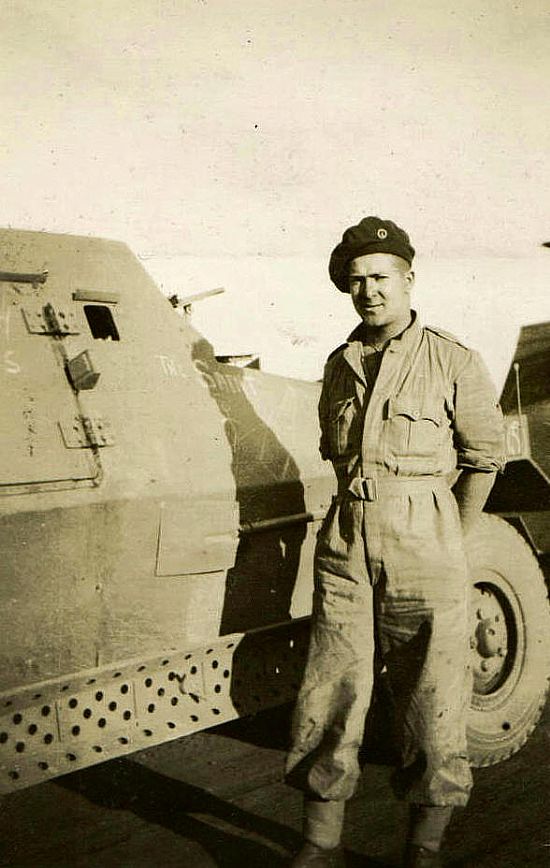
Brian Watson in North Africa with his armoured car.
I have an album that he compiled of his army experiences. Of all the inherited photos this is perhaps the most significant, but it got severely damaged by damp when we emigrated. Many pages are stuck together and photos ruined, but the following are in reasonable condition.
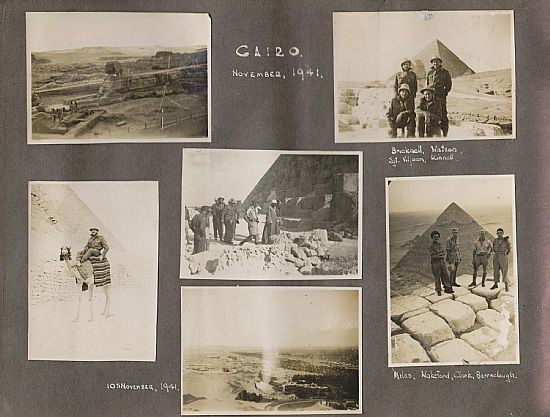
On arrival in Egypt, the troops managed some sight seeing.
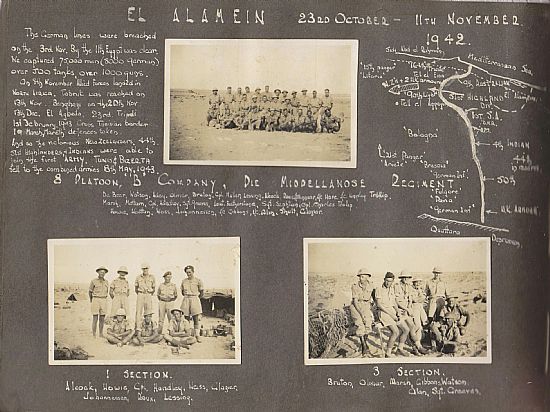
This page is well illustrated with a map and description of the Battle of Alamein.
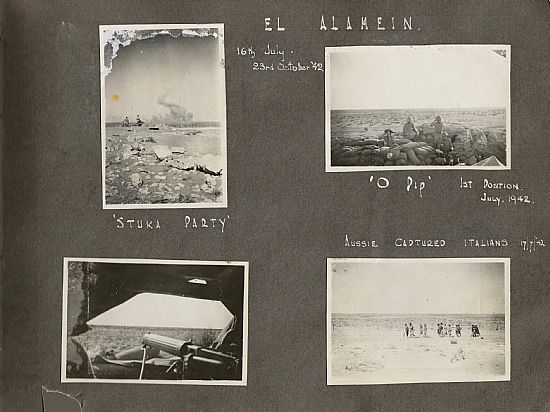
Another page of El Alamein showing Italian prisoners of war captured by the Australians who were serving alongside the South Africans.
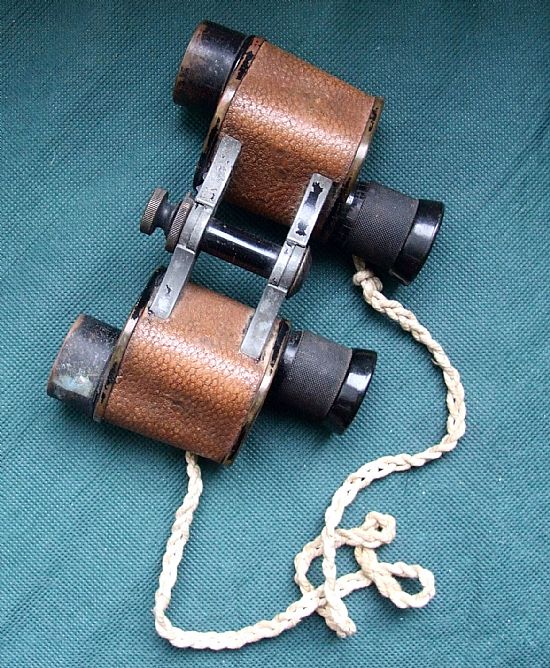
These are my father's army binoculars. (The string I added in my teens to replace the broken strap and to go bird watching).
Not all of his time in North Africa was battle related. His photos show him and others visiting the glories of ancient Egypt or swimming. I have a card advertising "THE BRITISH POPULAR TEA ROOM & RESTAURANT" in Alexanderia and another promoting G. B. Tawa's "PERSIAN CARPETS ANTIQUITIES AND CURIOS - sole agent for AMRIA BEDUIN RUGS".
An indentification certificate shows him as no. 11922 Rank Pte Name Watson B.W. The bearer has returned to the UNnon on leave from Active Service. Date stamped 18-1-1941. HAY PADDOCK CAMP
The we find his leave pass dated 13/4/43 for the purpose of proceeding to/on Durban.
I have a card from the mayor of Durban welcoming the troops back:
The Mayor and the City Councl of Durban offer you their very best wishes for a
happy holiday and a safe return to those you love.
May the knowledge that you have nobly doen your duty and well upheld the honour of South Africa be a source of pride to you as long as life lasts.
CITY HALL,
DURBAN,
January, 1943.
Signed by the Mayor.
Back home in East London he receives another card :
Welcome Greeting
The Mayor, Councillors and Citizens of East London bid you welcome home, and express their heartfelt thanks for the great service you have already rendered to our common cause and country in defence of liberty.
May you have a pleasant reunion with your families and friends, and a good holiday to restore you afetr the rigours of the campaign in which you and your comrades have maintained the proud traditions of South African arms.
And may you soon have the satisfaction of sharing the ultimate victory with your comrades-in-arms from the Mother Country and other parts of the Empire and be able to return home again to help in the work of reconstruction after the war.
On the reverse is this:
The Bearer of the Card
11922 Pte. Watson. B. W.
22nd January, 1943.
is entitled on presentation of his or her leave card, to Free Transport on Municipal Omnibuses and to Free Bathing Facilities at Orient Bath and Orient Beach, and by kind permission of African Theatres, Ltd., will be admitted Free to performances at the Colosseum (Saturdays and Holidays excepted).
After the war Brian remained a staunch supporter of the Kaffrarian Rifles and contributed to the book by Francis L. Coleman : NUNC ANIMIS' THE KAFFRARIAN RIFLES 1876-1986 (See BIBLIOGRAPHY).
I have some of his medals and clasps. A formal issue sheet notes the following 5 out a potential 11. The "number of stars, medals, clasps or emblems enclosed" is "5" although only 4 are described. He seems to have received an additional ribbon to go with the Africa Star as is pinned by him over the 1939-45 Star. The columns note the order in which Awards should be set up e.g. for framing / Description of Ribbon / Clasp of Emblem (if awarded)
- 1939-45 Star - Dark blue, red and light blue in three equal vertical stripes / This ribbon is worn with the dark blue stripe furthest from the left shoulder. / Battle of Britain.
- Africa Star - pale buff, with a central vertical red stripe and two narrower stripes, one dark blue, and the other light blue. This ribbon is worn with the dark blue stripe furthest from the left shoulder. / 8th Army.
- War Medal 1939-45 - A narrow central red stripe with a narrow white stripe on either side. A broad red stripe at either edge, and two intervening stripes in blue. / Oak leaf.
- Africa Service Medal. - Orange in colour with green and gold of the Springbok Colours in vertical stripes on either side. The green stripes being on the outside. / Protea
These came with clasps in two sizes. The larger one has orange flashes pinned on, presumably by him simply to keep them. The smaller one has "8" on the 2nd ribbon to signify the 8the Army. The obverse of the two stars is inscibed with "11922 B.W. WATSON". The face of the War Medal 1935-1945 has King George and the obverse a lion killing a griffin. The face of the Africa Service medal has an outline of the continent and the obverse a leaping springbok.
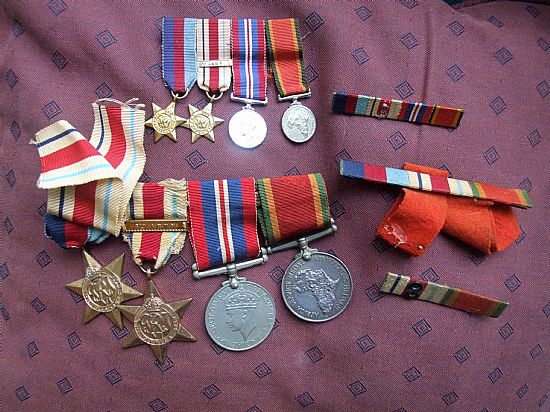
The Kaffrarian Rifles in North Africa
The unit served in the Eigth Army which was a field army formation of the British Army during the Second World War, fighting in the North African and Italian campaigns. Units came from Australia, British India, Canada, Free French Forces, Greece, New Zealand, Poland, Rhodesia, South Africa and the United Kingdom.
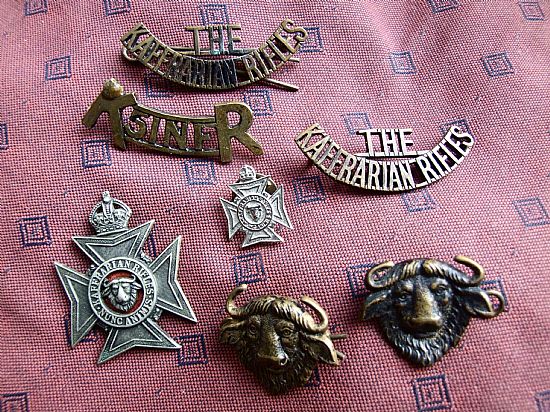
Change of regiment name
The Kaffrarian Rifles gained their name from the historical British Kaffraria area. Although few really thought of it. the term derives from the same source as the derogatory term and it is no surprise that in modern South Africa it was changed. It is now The Buffalo Volunteer Rifles (BVR), an infantry regiment of the South African Army. As a reserve unit, it has a status roughly equivalent to that of a British Army Reserve or United States Army National Guard unit.
The buffalo emblem was already integrated into the logo and has been redesigned to suit. The buffalo referring to the Buffalo River and the first defensive camp there. Fort Buffalo, in 1847 (before Fort Glamorgan).
Various buttons and other insignia
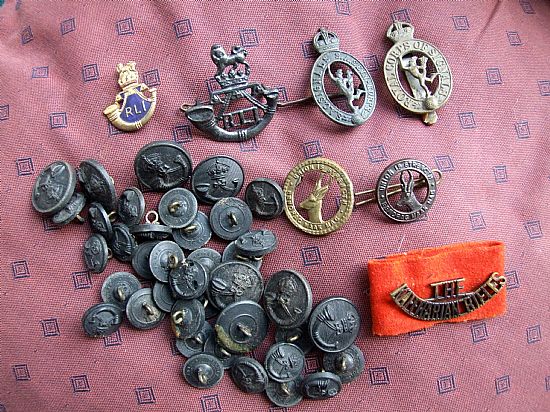
CASUAL OBSERVER : https://thecasualobserver.co.za/port-elizabeth-yore-town-war-world-war-ii/
SA MILITARY HISTORY : http://samilitaryhistory.org/vol112ml.html

